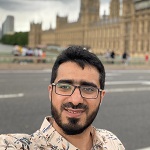Conference Program
Dr Sergey a researcher-immunologist, a clinician, graduated from Astrakhan State Medical University, Russia, in 1980. Suchkov has been trained at the Institute for Medical Enzymology, The USSR Academy of Medical Sciences, National Center for Immunology (Russia), NIH, Bethesda, USA, and British Society forImmunology to cover 4 British university facilities. Since 2005, Dr Suchkov has been working as Professor of I.M. Sechenov First Moscow State Medical University and of A.I.Evdokimov Moscow State Medical & Dental University. In 1995-2005, Suchkov was a Director of the Russian-American Program in Immunology of the Eye Dis-eases.Dr Suchkov is a member of EPMA (European Association of Predictive, Preventive and Person-alized Medicine,Brussels-Bonn), a member of the NY Academy of Sciences, a member of the Editorial Boards for Open Journal of Immunology, EPMA J., and Personalized Medicine Universe, and others. Now Suchkov is a Chair of Dept for Personalized & Translational Medicine, and Director, Center for Personalized & Translational Reproductology, I.M.Sechenov First Moscow State Medical University. Prof Sergey Suchkov, MD, PhD Chair, Dept for Personalized and Translational Medicine, Director, Center for Personalized Reproductology & Pediatrics, I.M.Sechenov First Moscow State Medical University, Moscow, Russia Member, EPMA, Brussels, EU Member, PMC, Washington, DC, USA Member, ISPM, Tokyo, Japan Member, New York Academy of Sciences Member, ACS, USA Member, AHA, USA Member, AMEE, Dundee, UK Secretary General, UCC, Cambridge, UK.

Sergey SuchkovMoscow State University, Russia
10 : 00- 10 : 40
Upon the initial licensure the life of a medicine or vaccines starts. An essential part of this is a continuous update through variation to the original license, known as post approval changes (PAC). These changes are done to enhance robustness and efficiency of the manufacturing process, improve QC techniques, upgrade to state-of-the art facilities and continuously update to meet regulatory and safety information. However, throughout the world there is a wide range of guidance governing PACs. A comparison of these regulations/guidelines, requirements, and procedures for management of PACs from some key countries across the world was performed. Our results show the lack of alignment between them and in addition also demonstrates the lack of predictability of timelines for review and approval in many countries. The latter, especially, has a considerable impact on the supply chain flexibility and by consequence may limit access for patients to that most up to date medicines and vaccines. The WHO guidelines, which are comprehensive and could represent a consensual model for alignment. Unfortunately, these WHO guidelines are still underused. Reliance on the review and approval by the health authority in country of origin, other Stringent Regulatory Authorities (soon to be WHO listed Authorities or WHO-PQ could be another way forward. These and other options or opportunities to improve the management of changes during the product lifecycle will be outlined. Ultimately, industry and regulators owe it to patients to provide and facilitate access to the most up to date versions of medicines and vaccines.

Mic McGoldrickAssociate Director Global CMC Policy at Merck, USA
10 : 45- 11 : 25

,
11 : 25-11 : 45
Hongwei Yu is a Professor at the Medical College of Wisconsin, USA. His research interest includes gene and molecular therapy for chronic pain. His research focuses on designing, cloning, production, and application of recombinant adeno-associated viral (AAV) vectors to manipulate genes of interests in vivo in the peripheral sensory nervous system for studying pain molecular mechanism and for treating chronic pain.

Hongwei YuMedical College of Wisconsin, USA
11 : 45- 12 : 05
Fan Fan is an Associate Professor at University of Mississippi Medical Center, USA. Her lab has used multidisciplinary approaches with an array of techniques to investigate how microvascular dysfunction contributes to end-organ damage, including vascular cognitive impairment, Alzheimer's disease-related dementias (ADRD), stroke, and renal disease, especially with aging, hypertension, and diabetes.

Fan FanUniversity of Mississippi Medical Center, USA
12 : 10- 12 : 40
Milan Sen?anski currently holds the position of Senior Research Associate at Vinca Institute of Nuclear Sciences in Belgrade, Serbia. He received his PhD in Physical Chemistry in 2011 at University of Belgrade, Serbia. His research interests include various in silico approaches as tools in the discovery of new ligands or drug repurposing for chronic and infectious diseases.

Milan SencanskiVinca Institute of Nuclear Sciences , Serbia
12 : 45- 13 : 05
Max Trebilcock is a certified Responsible Person for GDP, Medical Devices, and Cosmetics, and a member of the Chartered Institute of Quality Assurance. Max has over two decades of experience in Supply Chain, Operations, Project Management, Quality Assurance and Regulatory Affairs working with leading brands implementing effective change management and business infrastructure. His recent achievements include the construction of healthcare supply chain systems across EMEA, construction and implementation of global Quality Management systems for a leading legacy healthcare brand present in 32 global markets, and the successful medicinal license applications and ISO 13485 accreditation.

Max Trebilcock Vega Product Solutions , UK
13 : 10-13 : 30

,
13 : 30-14 : 30
Melissa Brod is the Vice President, Account Director and Pharmaceutical Principal, of VAT IT USA. Melissa holds a Bachelor of Arts in Political Science from the University of Michigan and a Master of Arts in Business from University of Miami. Melissa comes to VAT IT with the acquisition of Meridian VAT Reclaim where she was one of the original employees in the US region. Melissa, based in NYC, manages many of VAT IT’s global clients and brings her extensive VAT expertise across many verticals to the organization, with a particular emphasis on pharmaceuticals/biopharma.

Melissa Brod VATIT, USA
14 : 30- 15 : 00
Ramon Grasmeijer is an experienced professional with 20 + years of experience in the High Impact Meetings and Events industry. He is working with GCO Global since 2002 in a variety of different roles in Sourcing, Operations, Account Management and Strategic Meetings Management Consultancy. Prior to joining GCO he has gained experience within the Hospitality industry, predominantly involved in servicing large International Organizations on a Global scale, looking after their Worldwide Corporate Travel Programs as well as their Meeting & Event programs. As a Lead Consultant specialized in the Life Sciences industry, he delivers Risk Management Solutions tackling stakeholder interaction challenges, whilst managing costs as well as risks and Strategic Meeting Management services.

Ramon GrasmeijerGCO Global, The Netherlands
14 : 30- 15 : 00
Xolani Henry Makhoba currently works as a Senior Lecturer and Researcher at the University of Fort-Hare under the Department of Biochemistry and Microbiology. He's involved in malaria research, searching for alternative vaccines or drugs for malaria. He’s also involved in diabetes research looking for innovative ways to speed up wound healing in diabetic patients (in collaboration with the George Washington DC University). Dr. Makhoba is in collaboration with the University of Oxford is also involved in SARS-CoV-2 project looking at innovative strategies to halt the virus to hijack human host cells folding machinery. Dr. Makhoba has established several collaborations both local and international with intentions to exchange knowledge in the field of science. He has a strong background in cell biology, plant biochemistry/biology, cell or tissue culture, molecular biology, biotechnology, bioinformatics, next-generation sequences, real-time PCR just to name a few. He's involved in post-graduate supervision and has been involved in curriculum development in the department. He has the potential to raise funding from external sources. He was previously funded by research development program (RDP) and currently funded by SA-MRC (2022-2024). Dr. Makhoba serves in several committees in the Department (Biochemistry and Microbiology). He has served in various panels at National Research Foundation (NRF). He is also holding membership in the International Biochemistry Society.

Xolani Henry MakhobaUniversity of Fort Hare, South Africa
15 : 05- 15 : 25
Islam M. Adel is an assistant lecturer of Pharmaceutics and Industrial Pharmacy at Faculty of pharmacy, Cairo University. He studied pharmaceutical sciences at Faculty of pharmacy, Cairo University . Adel has his expertise in the formulation and evaluation of scaffolds and nanoparticles together with reviews in the field of inhalation drug delivery and scaffold fabrication techniques.

Islam Mohamed Adel Mahmoud HashimCairo University, Egypt
15 : 30- 15 : 50
To be updated soon.

Santwana K CNational University of Singapore, Singapore
15 : 50-16 : 05
Background: The novel coronavirus (SARS-CoV-2) that emerged in December 2019, resulting in COVID-19, continues to affect the population, putting more pressure on healthcare systems and global socioeconomic balances. The World Health Organization declared COVID-19 a global pandemic, referring to approximately 179 million confirmed cases and 3.87 million confirmed deaths as of June 2021. Easy in vitro viral systems are required to study viral entry and sera neutralisation of the different emerging strains of SARS-CoV-2. Methods: The aim was to generate an HIV-1 pseudotyped virus particle (PVP) system that expresses spike protein (CoV-S2wt) and compare infectivity profiles in two different cells, 293T and 293T-ACE2. We also monitored infection in macrophages (MQ), Dendritic Cells (DCs) and Vero cells. Furthermore, we tested SARS-CoV-S2wt PVP treated with COVID-19 patient's sera to investigate neutralisation capacity. Results: We generated HIV-1 PVP expressing SARS-CoV-2S2 protein, which infected 293T-ACE2 cells but less efficiently 293T cells, showing the development of a virus mimicking SARS-CoV-2. This virus was successfully neutralised with patient sera generated from acute infected COVID-19 patients. The same viruses were tested for infectivity of MQ, DCs and Vero cells and where it was shown to be infectious, but to far lower levels as on 293T-ACE2 cells. These results indicate that primary cells of the immune system can be infected with SARS-CoV-2 to low levels. Conclusions: We have demonstrated the successful generation of an HIV-1 PVP expressing SARS-CoV-2Swt protein, which infects cells expressing the ACE2 receptor and can be inhibited with sera from COVID-19 survivors. Utilising these viruses, we demonstrate that MQ, DCs and Vero cells can be infected to low levels.

Abdullateef AlshehriUniversity of Liverpool, UK
16 : 10- 16 : 25
Airway organoids can be generated from primary airway epithelial cells and can recapitulate the organization and key functions of the epithelium in vivo. These properties render them an attractive alternative to the Air-Liquid Interface (ALI) cell culture model, although the closed architecture of the organoids with the apical side facing the lumen limits their application in assays requiring apical-specific interactions, such as host-pathogen interactions. To address this limitation, we have developed the PneumaCult Apical-Out Airway Organoid Medium, which is used in an ECM-free workflow that promotes generation of a large number of airway organoids that expose their apical surface to the environment. Apical out airway organoids (Ap-O AO) are composed of basal and ciliated cells and display reproducible morphology, organization and functional characteristics of the airway epithelium. Ap-O AO are susceptible to infection with common airway viruses such as Influenza A, Influenza B, Rhinovirus A16, and Enterovirus D68, and produce high viral RNA titers and have readily observable cytopathogenic effects (CPE). Treatment of Ap-O AO with two antiviral drugs, Rupintrir and Itraconazole, following infection with Enterovirus D68 demonstrates that this organoid system is also able to model the inhibitory effects of drug in vitro. In summary, PneumaCult Apical-Out Airway Organoid Medium supports the efficient and reproducible generation of apical out airway organoids that are susceptible to viral infections and show high potential for supporting high-throughput downstream applications.

Salvatore SimminiSTEMCELL Technologies , UK
Poster-
To be updated soon

Ayed Awad DeraKing Khalid University, Saudi Arabia
Poster-
To be updated soon.

Mareike WerleQueen Mary University of London, UK
Poster-

,
16 : 35-16 : 55
Principal Research Leader, Professor Michael F. Good AO heads the Laboratory of Vaccines for the Developing World, Institute for Glycomics, Griffith University on the Gold Coast, Queensland. He is the past Chairman of the National Health and Medical Research Council, Director of the Queensland Institute of Medical Research and President of the Association of Australian Medical Research Institutes (AAMRI). Professor Good’s interests are in the field of immunity and immunopathogenesis to malaria and group A streptococcus/ rheumatic fever, with particular relevance to the development of vaccines. In 2008 Professor Good was awarded an Order of Australia for his services to medical research and in 2009 he received the Eureka Prize for Leadership. In 2010, Professor Good was a recipient of the Queensland Greats Awards. Professor Good was elected Fellow of the Australian Academy of Health and Medical Sciences (FAHMS) in 2015.

Michael F GoodGriffith University , Australia
16 : 55- 17 : 10
Prof. Daniela Monti graduated in Chemistry and Pharmaceutical Technology and received the PhD in "Design, Development and Bio-?evaluation of Drugs". In 2000, she became Assistant Professor of Pharmaceutical Technology and currently she holds the role of Associate Professor at the Department of Pharmacy, University of Pisa. Her scientific research is oriented towards the study of drug delivery systems to the cutaneous, ungual, ocular, vaginal and buccal site, the use of cell cultures to evaluate toxicity on corneal epithelium cells of ophthalmic excipients and the cosmetic field. From 1997 to 2000 he participated in the European project BIOMED-?2, (BMH4-?97-?2324) entitled "Evaluation of oculotoxicity of drugs in vitro" with the following European partners: University of Tampere (Finland), University of Bremen (Germany), University of Ioannina (Greece), Orion Corporation Ltd. and Oy Star AB, (Finland). She is also responsible for several research projects involving international companies. Furthermore, she is the author of many publications in international journals with referee, of patents and presented her research at national and international meetings. She has been reviewer for many scientific journals.

Daniela MontiUniversity of Pisa, Italy
17 : 15-17 : 30
A digital practitioner. Mr. Paciorkowski holds a Master's degree in Artificial Intelligence and is a co-author of multiple publications and one patent. His passion is to address real world challenges in pharma and biotech by creating meaningful innovative solutions. A frequent speaker and university lecturer, who deals with the topic of Lab of the Future, flexibility, connectivity and scalability. In a very visual, unconventional, and sometimes provocative way, he encourages listeners to think outside the box and look at the technology topics from an unusual perspective. Before he created A4BEE, Mr. Paciorkowski worked at Accenture as Senior Manager and IoT Domain Lead and Executive Architect and Cloud Advisor at IBM.
